sensor TOYOTA TACOMA 2019 Owners Manual (in English)
[x] Cancel search | Manufacturer: TOYOTA, Model Year: 2019, Model line: TACOMA, Model: TOYOTA TACOMA 2019Pages: 60, PDF Size: 3.28 MB
Page 3 of 60
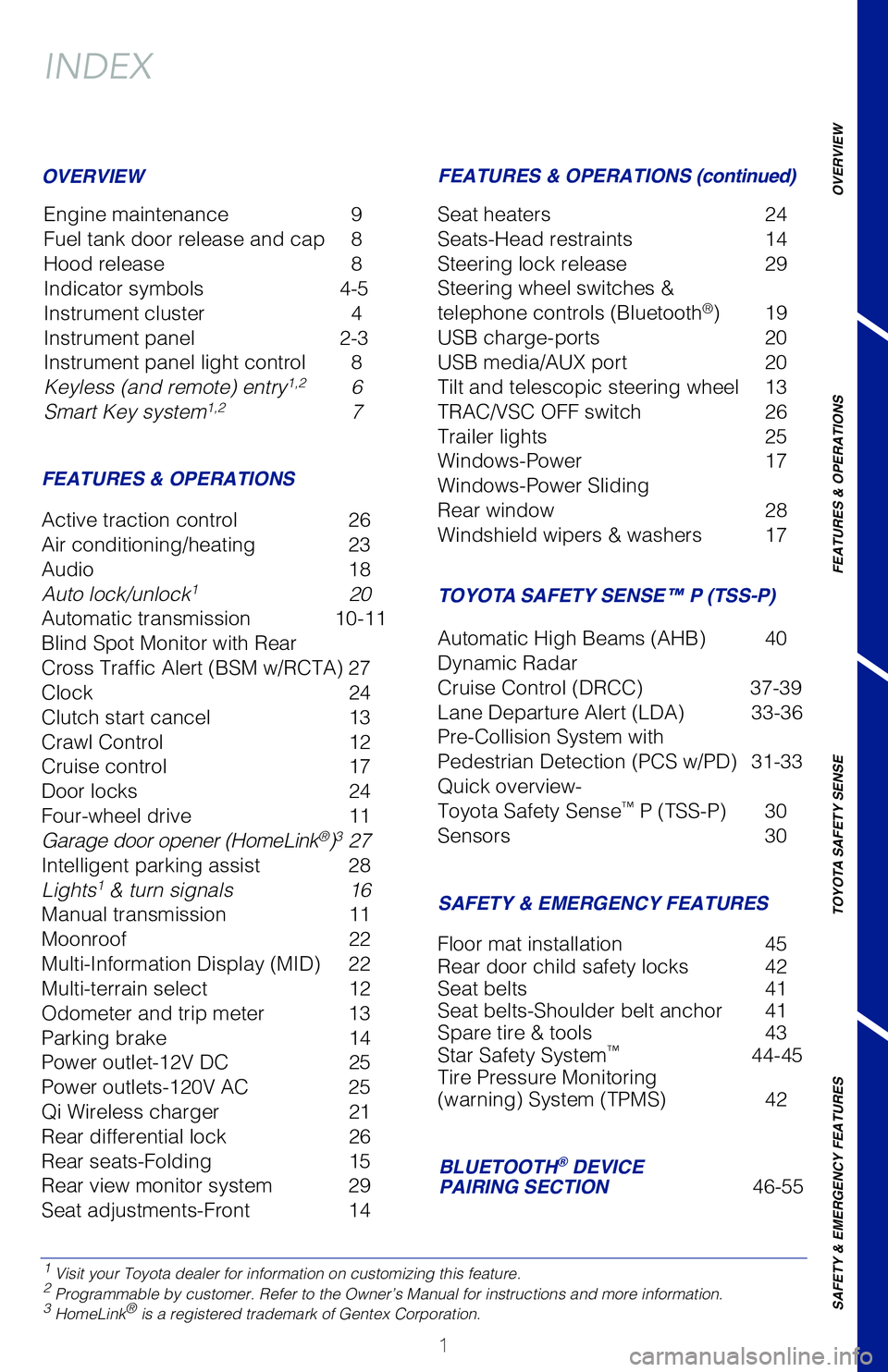
1
OVERVIEW
FEATURES & OPERATIONS
TOYOTA SAFETY SENSE
SAFETY & EMERGENCY FEATURES
1 Visit your Toyota dealer for information on customizing this feature.2 Programmable by customer. Refer to the Ownerâs Manual for instructio\
ns and more information.3 HomeLinkÂŽ is a registered trademark of Gentex Corporation.
INDEX
Engine maintenance 9
Fuel tank door release and cap 8
Hood release 8
Indicator symbols 4-5
Instrument cluster 4
Instrument panel 2-3
Instrument panel light control 8
Keyless (and remote) entry
1,2 6
Smart Key system1,2 7
OVERVIEW
FEATURES & OPERATIONS FEATURES & OPERATIONS (continued)
SAFETY & EMERGENCY FEATURES
Active traction control
26
Air conditioning/heating 23
Audio 18
Auto lock/unlock
1 20
Automatic transmission 10-11
Blind Spot Monitor with Rear
Cross Traffic Alert (BSM w/RCTA) 27
Clock 24
Clutch start cancel 13
Crawl Control 12
Cruise control 17
Door locks 24
Four-wheel drive 11
Garage door opener (HomeLink
ÂŽ)3 27
Intelligent parking assist 28
Lights
1 & turn signals 16
Manual transmission 11
Moonroof 22
Multi-Information Display (MID) 22
Multi-terrain select 12
Odometer and trip meter 13
Parking brake 14
Power outlet-12V DC 25
Power outlets-120V AC 25
Qi Wireless charger 21
Rear differential lock 26
Rear seats-Folding 15
Rear view monitor system 29
Seat adjustments-Front 14 Seat heaters
24
Seats-Head restraints 14
Steering lock release 29
Steering wheel switches &
telephone controls (Bluetooth
ÂŽ) 19
USB charge-ports 20
USB media/AUX port 20
Tilt and telescopic steering wheel 13
TRAC/VSC OFF switch 26
Trailer lights 25
Windows-Power 17
Windows-Power Sliding
Rear window 28
Windshield wipers & washers 17
Floor mat installation 45
Rear door child safety locks 42
Seat belts 41
Seat belts-Shoulder belt anchor 41
Spare tire & tools 43
Star Safety System
⢠44-45
Tire Pressure Monitoring
(warning) System (TPMS) 42
TACOMA 2019
This Quick Reference Guide is a summary of basic vehicle
operations. It contains brief descriptions of fundamental
operations so you can locate and use the vehicleâs main
equipment quickly and easily.
The Quick Reference Guide is not intended as a substitute for
the Ownerâs Manual located in your vehicleâs glove box. We
strongly encourage you to review the Ownerâs Manual and
supplementary manuals so you will have a better understanding
of your vehicleâs capabilities and limitations.
Your dealership and the entire staff of Toyota Motor North
America, Inc. wish you many years of satisfied driving in your
new Tacoma.
A word about safe vehicle operations
This Quick Reference Guide is not a full description of Tacoma operation\
s.
Every Tacoma owner should review the Ownerâs Manual that accompanies
this vehicle.
Pay special attention to the boxed information highlighted in color throughout
the Ownerâs Manual. Each box contains safe operating instructions to \
help you
avoid injury or equipment malfunction.
All information in this Quick Reference Guide is current at the time of \
printing.
Toyota reserves the right to make changes at any time without notice.
BLUETOOTHÂŽ DEVICE
PAIRING SECTION 46-55
TOYOTA SAFETY SENSE⢠P (TSS-P)
Automatic High Beams (AHB) 40
Dynamic Radar
Cruise Control (DRCC) 37-39
Lane Departure Alert (LDA) 33-36
Pre-Collision System with
Pedestrian Detection (PCS w/PD) 31-33
Quick overview-
Toyota Safety Sense
⢠P (TSS-P) 30
Sensors 30
142230_MY19_Tacoma_QRG_GUTS.indd 18/14/18 12:43 PM
Page 28 of 60
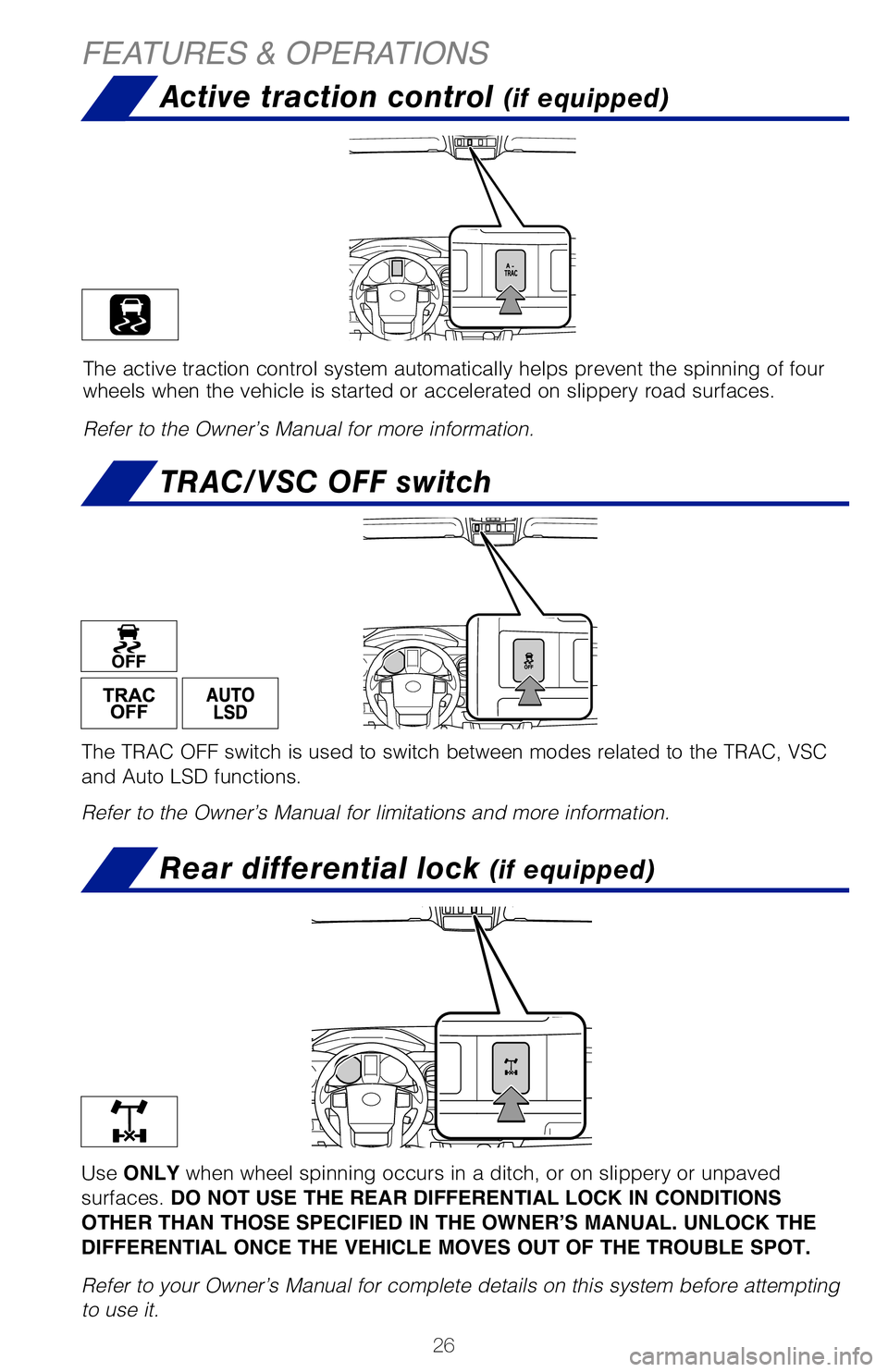
26
Active traction control (if equipped)
TRAC/VSC OFF switch
Rear differential lock (if equipped)
FEATURES & OPERATIONS
The active traction control system automatically helps prevent the spinning\
of four
wheels when the vehicle is started or accelerated on slippery road surfaces.
Refer to the Ownerâs Manual for more information.
Use ONLY when wheel spinning occurs in a ditch, or on slippery or unpaved
surfaces. DO NOT USE THE REAR DIFFERENTIAL LOCK IN CONDITIONS
OTHER THAN THOSE SPECIFIED IN THE OWNERâS MANUAL. UNLOCK THE
DIFFERENTIAL ONCE THE VEHICLE MOVES OUT OF THE TROUBLE SPOT.
Refer to your Ownerâs Manual for complete details on this system before at\
tempting
to use it.
The TRAC OFF switch is used to switch between modes related to the TRAC, VS\
C
and Auto LSD functions.
Refer to the Ownerâs Manual for limitations and more information.
Garage door openers manufactured under license from HomeLinkÂŽ* can be
programmed to operate garage doors, estate gates, security lighting, etc.
Refer to âGarage door opener,â Section 6-4 in the Ownerâs Manual for more
details.
For programming assistance, contact HomeLink
ÂŽ at 1-800-355-3515, or visit
http://www.homelink.com.
* HomeLinkÂŽ is a registered trademark of Johnson Controls, Inc.
The Blind Spot Monitor is a system that has two functions:
⢠The Blind Spot Monitor function (assists the driver in making the deci\
sion when changing lanes)
⢠The Rear Cross Traffic Alert function (assists the driver when backing\
up)
The system is designed to use radar sensors to detect vehicles traveling in\
the
Tacomaâs blind spot and advises the driver of the vehiclesâ presence via the
outside rear view mirror indicators.
*Rear Cross Traffic Alert function only.
Refer to the Ownerâs Manual for limitations and more details on this syste\
m before
attempting to use it.
Outside rear view
mirror indicators
142230_MY19_Tacoma_QRG_GUTS.indd 268/13/18 4:06 PM
Page 29 of 60
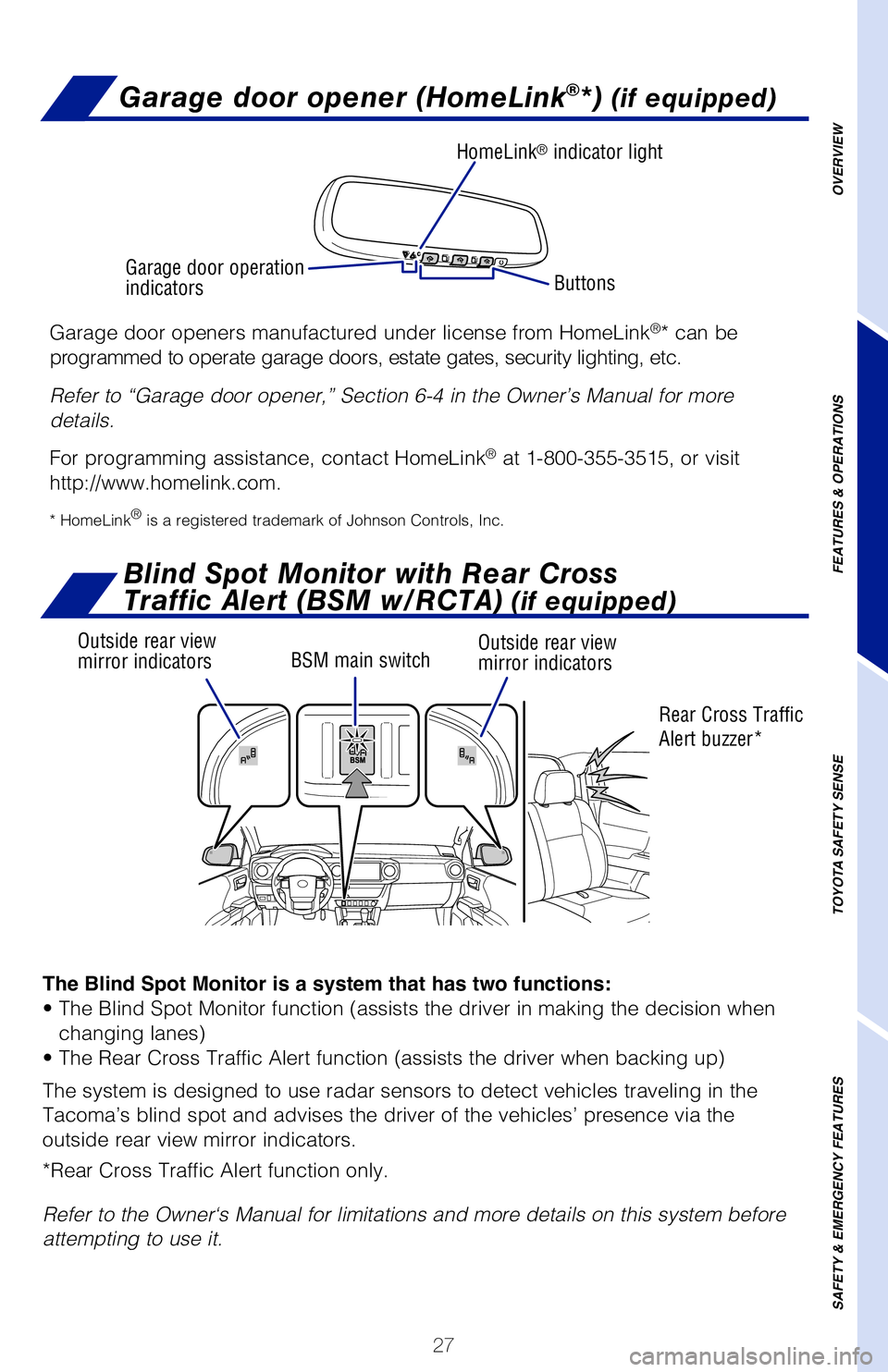
27
Garage door opener (HomeLinkÂŽ*) (if equipped)
The active traction control system automatically helps prevent the spinning\
of four wheels when the vehicle is started or accelerated on slippery road surfaces.
Refer to the Ownerâs Manual for more information.
Use ONLY when wheel spinning occurs in a ditch, or on slippery or unpaved
surfaces. DO NOT USE THE REAR DIFFERENTIAL LOCK IN CONDITIONS
OTHER THAN THOSE SPECIFIED IN THE OWNERâS MANUAL. UNLOCK THE
DIFFERENTIAL ONCE THE VEHICLE MOVES OUT OF THE TROUBLE SPOT.
Refer to your Ownerâs Manual for complete details on this system before at\
tempting
to use it.
The TRAC OFF switch is used to switch between modes related to the TRAC, VS\
C
and Auto LSD functions.
Refer to the Ownerâs Manual for limitations and more information.
Garage door openers manufactured under license from HomeLinkÂŽ* can be
programmed to operate garage doors, estate gates, security lighting, etc.
Refer to âGarage door opener,â Section 6-4 in the Ownerâs Manual for more
details.
For programming assistance, contact HomeLink
ÂŽ at 1-800-355-3515, or visit
http://www.homelink.com.
* HomeLinkÂŽ is a registered trademark of Johnson Controls, Inc.
The Blind Spot Monitor is a system that has two functions:
⢠The Blind Spot Monitor function (assists the driver in making the deci\
sion when changing lanes)
⢠The Rear Cross Traffic Alert function (assists the driver when backing\
up)
The system is designed to use radar sensors to detect vehicles traveling in\
the
Tacomaâs blind spot and advises the driver of the vehiclesâ presence via the
outside rear view mirror indicators.
*Rear Cross Traffic Alert function only.
Refer to the Ownerâs Manual for limitations and more details on this syste\
m before
attempting to use it.
Blind Spot Monitor with Rear Cross
Traffic Alert (BSM w/RCTA)
(if equipped)
BSM main switch HomeLink
ÂŽ indicator light
Garage door operation
indicators Buttons
Outside rear view
mirror indicators Rear Cross Traffic
Alert buzzer*
Outside rear view
mirror indicators
OVERVIEW
FEATURES & OPERATIONS
TOYOTA SAFETY SENSE
SAFETY & EMERGENCY FEATURES
142230_MY19_Tacoma_QRG_GUTS.indd 278/13/18 4:07 PM
Page 30 of 60
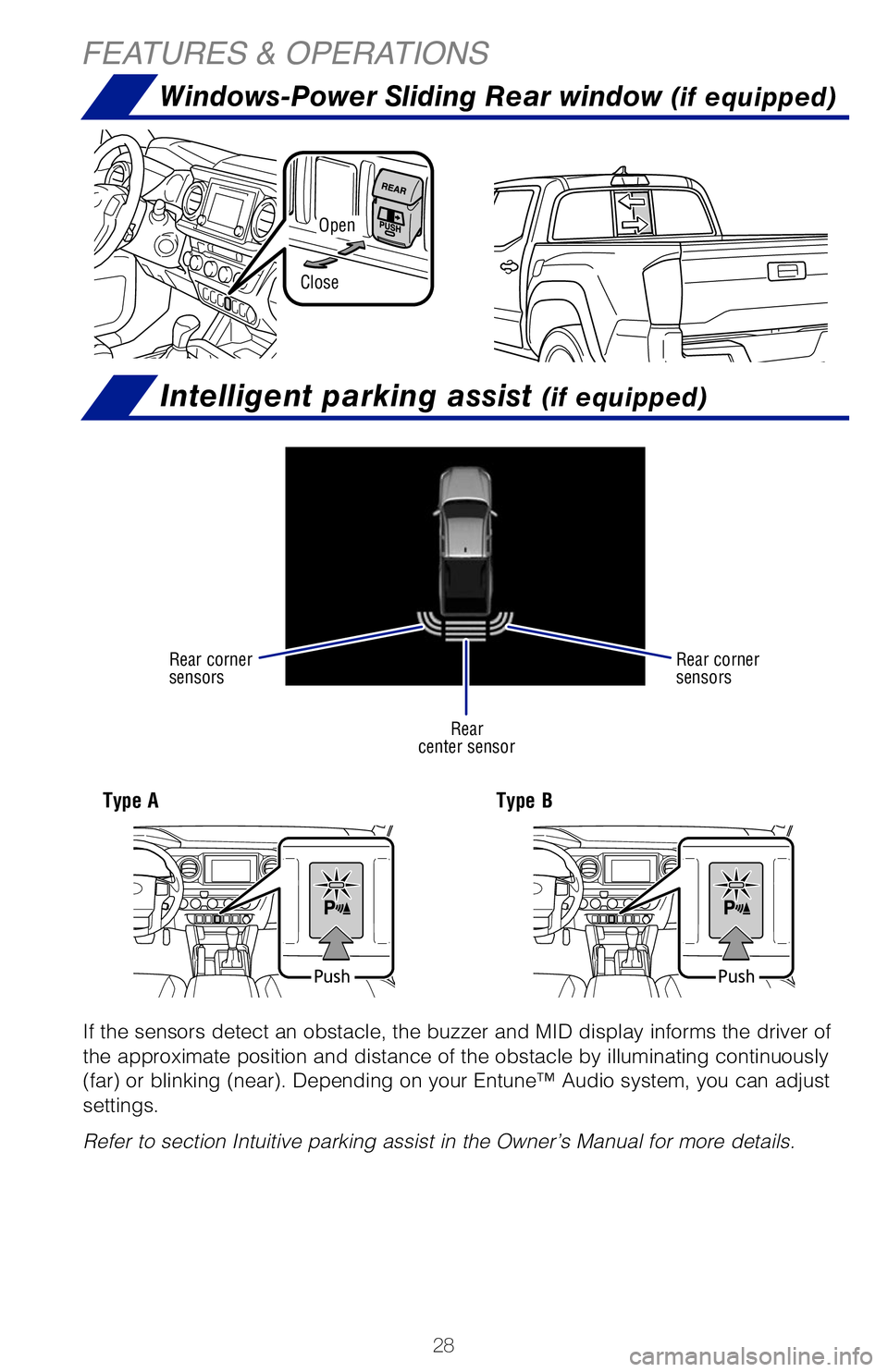
28
Intelligent parking assist (if equipped)
Windows-Power Sliding Rear window (if equipped)
FEATURES & OPERATIONS
If the sensors detect an obstacle, the buzzer and MID display informs th\
e driver of
the approximate position and distance of the obstacle by illuminating co\
ntinuously
(far) or blinking (near). Depending on your Entune⢠Audio system,\
you can adjust
settings.
Refer to section Intuitive parking assist in the Ownerâs Manual for m\
ore details.
PushPush
The rear view monitor system displays an image of the view from the bump\
er of the
rear area of the vehicle. The camera for the rear view monitor system is\
integrated
in the tailgate handle.
To adjust the image on the rear view monitor screen, press the âSETUP\
â button
and select âDisplayâ on the âSetupâ screen. Select âCame\
raâ to adjust the screen
contrast and brightness.
Refer to the Ownerâs Manual and Navigation and Multimedia System Owne\
râs
Manual for limitations and more details on this system.
Open
Close
Rear
center sensor
Rear corner
sensors
Rear corner
sensors
When starting the engine, the engine
switch may seem stuck in the âLOCKâ
position. To free it, turn the key while
turning the steering wheel slightly left
and right.
Without Smart Key system
Type AType B
142230_MY19_Tacoma_QRG_GUTS.indd 288/13/18 4:07 PM
Page 31 of 60
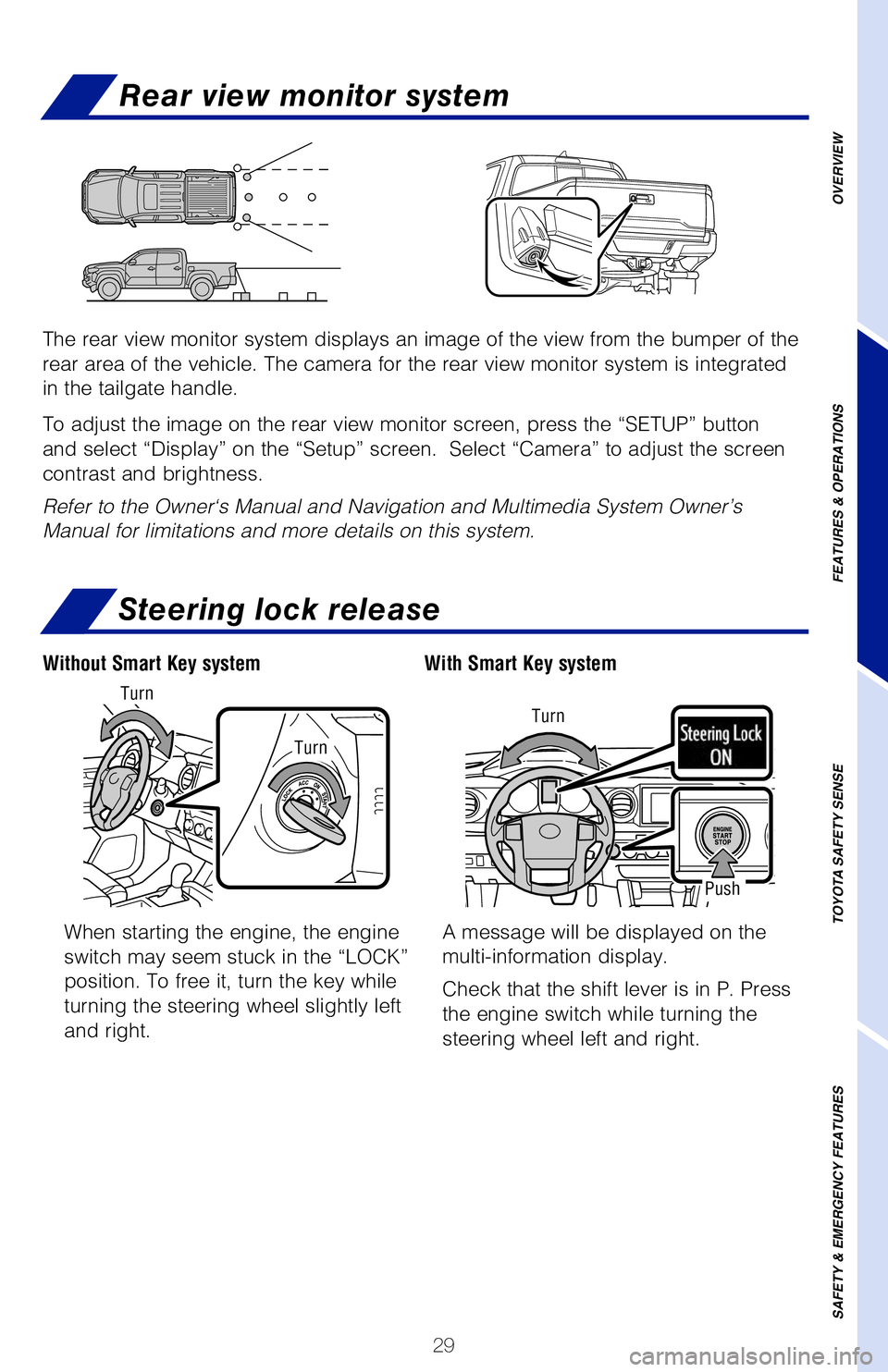
29
Rear view monitor systemWindows-Power Sliding Rear window (if equipped)
If the sensors detect an obstacle, the buzzer and MID display informs th\
e driver of
the approximate position and distance of the obstacle by illuminating co\
ntinuously
(far) or blinking (near). Depending on your Entune⢠Audio system,\
you can adjust
settings.
Refer to section Intuitive parking assist in the Ownerâs Manual for m\
ore details.
The rear view monitor system displays an image of the view from the bump\
er of the
rear area of the vehicle. The camera for the rear view monitor system is\
integrated
in the tailgate handle.
To adjust the image on the rear view monitor screen, press the âSETUP\
â button
and select âDisplayâ on the âSetupâ screen. Select âCame\
raâ to adjust the screen
contrast and brightness.
Refer to the Ownerâs Manual and Navigation and Multimedia System Owne\
râs
Manual for limitations and more details on this system.
OVERVIEW
FEATURES & OPERATIONS
TOYOTA SAFETY SENSE
SAFETY & EMERGENCY FEATURES
When starting the engine, the engine
switch may seem stuck in the âLOCKâ
position. To free it, turn the key while
turning the steering wheel slightly left
and right. A message will be displayed on the
multi-information display.
Check that the shift lever is in P. Press
the engine switch while turning the
steering wheel left and right.
Steering lock release
With Smart Key system
Without Smart Key system
Push
Turn
Turn
Turn
142230_MY19_Tacoma_QRG_GUTS.indd 298/13/18 4:07 PM
Page 32 of 60
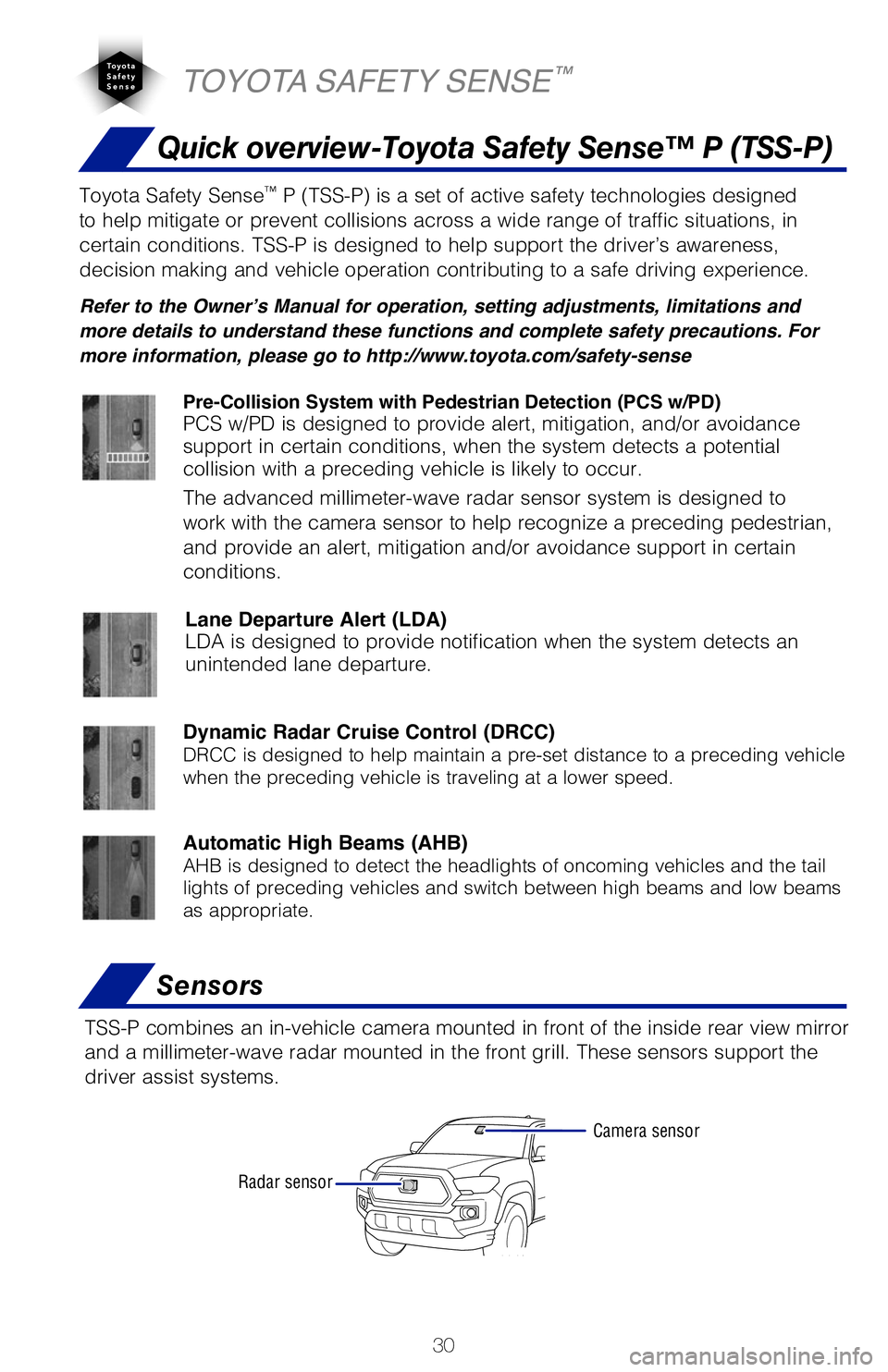
30
The Pre-Collision System uses a radar sensor and camera sensor to help d\
etect a
vehicle or pedestrian in front of your vehicle.
As there is a limit to the degree of recognition accuracy and control pe\
rformance
that this system can provide, do not overly rely on this system. This sy\
stem will not
prevent collisions or lessen collision damage or injury in every situati\
on. Do not use
PCS instead of normal braking operations under any circumstances. Do not\
attempt
to test the operation of the pre-collision system yourself, as the syste\
m may not
operate or engage, possibly leading to an accident. In some situations, \
such as
when driving in inclement weather such as heavy rain, fog, snow or a san\
dstorm or
while driving on a curve and for a few seconds after driving on a curve,\
a vehicle
may not be detected by the radar and camera sensors, preventing the syst\
em from
operating or engaging properly.
Refer to a Toyota Ownerâs Manual for a list of additional situations \
in which the
system may not operate properly.Refer to a Toyota Ownerâs Manual for additional information on PCS w/\
PD operation,
settings adjustments, limitations, and precautions before attempting to \
use it. Pre-Collision Warning
When the system determines that the possibility of a frontal collision i\
s high, a
buzzer will sound and a warning message will be displayed on the Multi-I\
nformation
Display (MID) to urge the driver to take evasive action.
Pre-Collision Brake Assist
If the driver notices the hazard and brakes, the system may provide addi\
tional
braking force using Brake Assist. This system may prime the brakes and m\
ay apply
greater braking force in relation to how strongly the brake pedal is dep\
ressed.
Pre-Collision Braking
If the driver does not brake in a set time and the system determines tha\
t the
possibility of a frontal collision with a preceding vehicle is extremely\
high, the
system may automatically apply the brakes, reducing speed in order to he\
lp the
driver reduce the impact and in certain cases avoid the collision.
Quick overview-Toyota Safety Sense⢠P (TSS-P)
Sensors
TSS-P combines an in-vehicle camera mounted in front of the inside rear \
view mirror
and a millimeter-wave radar mounted in the front grill. These sensors su\
pport the
driver assist systems.
TOYOTA SAFETY SENSEâ˘
Toyota Safety Sense⢠P (TSS-P) is a set of active safety technologies designed
to help mitigate or prevent collisions across a wide range of traffic si\
tuations, in
certain conditions. TSS-P is designed to help support the driverâs aw\
areness,
decision making and vehicle operation contributing to a safe driving exp\
erience.
Refer to the Ownerâs Manual for operation, setting adjustments, limitations and
more details to understand these functions and complete safety precautions. For
more information, please go to http://www.toyota.com/safety-sense
Automatic High Beams (AHB)AHB is designed to detect the headlights of oncoming vehicles and the ta\
il
lights of preceding vehicles and switch between high beams and low beams\
as appropriate. Pre-Collision System with Pedestrian Detection (PCS w/PD)
PCS w/PD is designed to provide alert, mitigation, and/or avoidance
support in certain conditions, when the system detects a potential
collision with a preceding vehicle is likely to occur.
The advanced millimeter-wave radar sensor system is designed to
work with the camera sensor to help recognize a preceding pedestrian,
and provide an alert, mitigation and/or avoidance support in certain
conditions.
Dynamic Radar Cruise Control (DRCC)
DRCC is designed to help maintain a pre-set distance to a preceding vehi\
cle
when the preceding vehicle is traveling at a lower speed.
Lane Departure Alert (LDA)
LDA is designed to provide notification when the system detects an
unintended lane departure.
Camera sensor
Radar sensor
142230_MY19_Tacoma_QRG_GUTS.indd 308/13/18 4:07 PM
Page 33 of 60
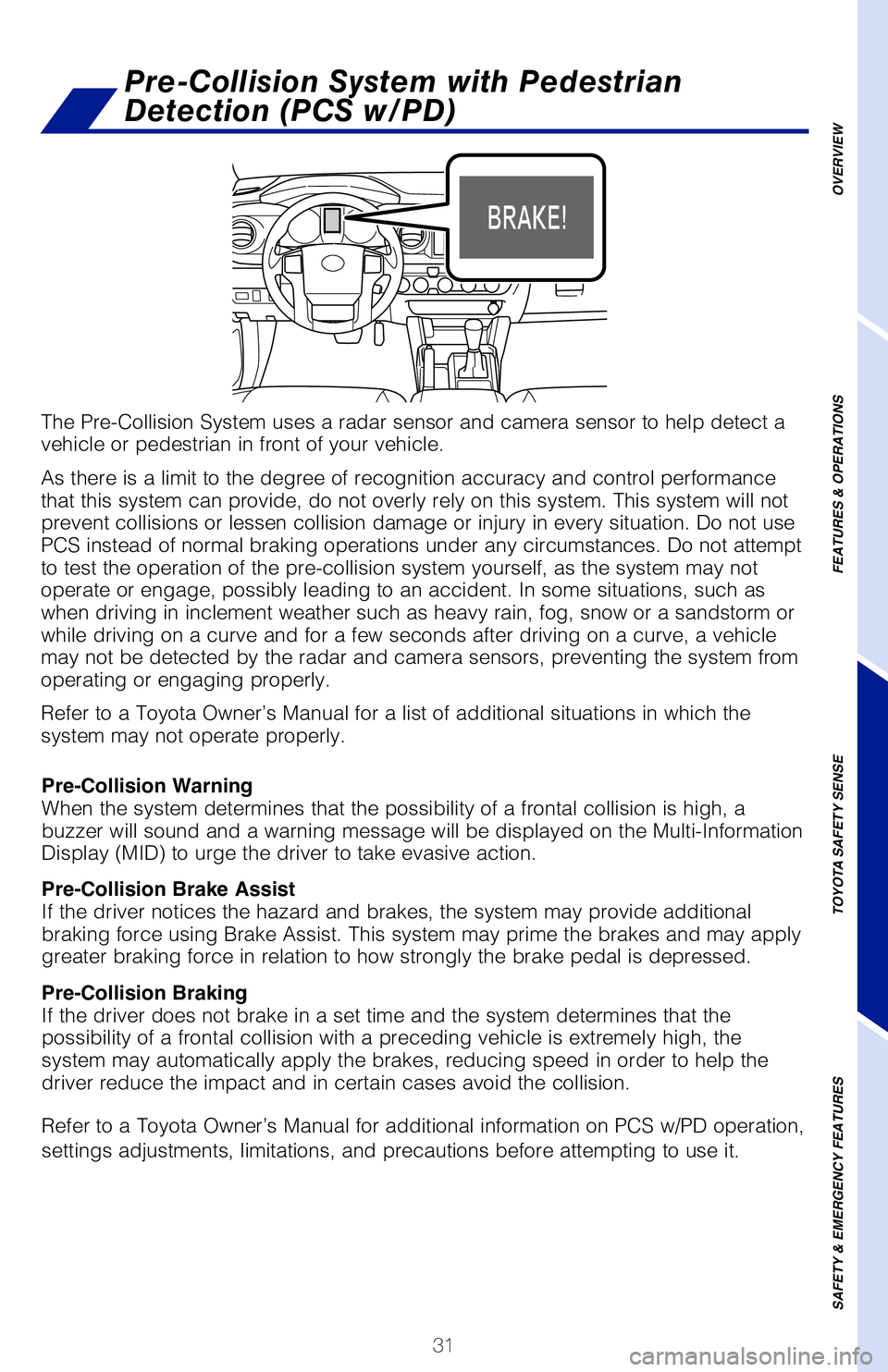
31
OVERVIEW
FEATURES & OPERATIONS
TOYOTA SAFETY SENSE
SAFETY & EMERGENCY FEATURES
The Pre-Collision System uses a radar sensor and camera sensor to help d\
etect a
vehicle or pedestrian in front of your vehicle.
As there is a limit to the degree of recognition accuracy and control pe\
rformance
that this system can provide, do not overly rely on this system. This sy\
stem will not
prevent collisions or lessen collision damage or injury in every situati\
on. Do not use
PCS instead of normal braking operations under any circumstances. Do not\
attempt
to test the operation of the pre-collision system yourself, as the syste\
m may not
operate or engage, possibly leading to an accident. In some situations, \
such as
when driving in inclement weather such as heavy rain, fog, snow or a san\
dstorm or
while driving on a curve and for a few seconds after driving on a curve,\
a vehicle
may not be detected by the radar and camera sensors, preventing the syst\
em from
operating or engaging properly.
Refer to a Toyota Ownerâs Manual for a list of additional situations \
in which the
system may not operate properly.
Refer to a Toyota Ownerâs Manual for additional information on PCS w/\
PD operation,
settings adjustments, limitations, and precautions before attempting to \
use it. Pre-Collision Warning
When the system determines that the possibility of a frontal collision i\
s high, a
buzzer will sound and a warning message will be displayed on the Multi-I\
nformation
Display (MID) to urge the driver to take evasive action.
Pre-Collision Brake Assist
If the driver notices the hazard and brakes, the system may provide addi\
tional
braking force using Brake Assist. This system may prime the brakes and m\
ay apply
greater braking force in relation to how strongly the brake pedal is dep\
ressed.
Pre-Collision Braking
If the driver does not brake in a set time and the system determines tha\
t the
possibility of a frontal collision with a preceding vehicle is extremely\
high, the
system may automatically apply the brakes, reducing speed in order to he\
lp the
driver reduce the impact and in certain cases avoid the collision.
Pre-Collision System with Pedestrian
Detection (PCS w/PD)
Quick overview-Toyota Safety Sense⢠P (TSS-P)
Sensors
TSS-P combines an in-vehicle camera mounted in front of the inside rear \
view mirror
and a millimeter-wave radar mounted in the front grill. These sensors su\
pport the
driver assist systems.
Toyota Safety Sense
⢠P (TSS-P) is a set of active safety technologies designed
to help mitigate or prevent collisions across a wide range of traffic si\
tuations, in
certain conditions. TSS-P is designed to help support the driverâs aw\
areness,
decision making and vehicle operation contributing to a safe driving exp\
erience.
Refer to the Ownerâs Manual for operation, setting adjustments, limitations and
more details to understand these functions and complete safety precautions. For
more information, please go to http://www.toyota.com/safety-sense
Automatic High Beams (AHB)AHB is designed to detect the headlights of oncoming vehicles and the ta\
il
lights of preceding vehicles and switch between high beams and low beams\
as appropriate. Pre-Collision System with Pedestrian Detection (PCS w/PD)
PCS w/PD is designed to provide alert, mitigation, and/or avoidance
support in certain conditions, when the system detects a potential
collision with a preceding vehicle is likely to occur.
The advanced millimeter-wave radar sensor system is designed to
work with the camera sensor to help recognize a preceding pedestrian,
and provide an alert, mitigation and/or avoidance support in certain
conditions.
Dynamic Radar Cruise Control (DRCC)
DRCC is designed to help maintain a pre-set distance to a preceding vehi\
cle
when the preceding vehicle is traveling at a lower speed.
Lane Departure Alert (LDA)
LDA is designed to provide notification when the system detects an
unintended lane departure.
142230_MY19_Tacoma_QRG_GUTS.indd 318/13/18 4:07 PM
Page 34 of 60
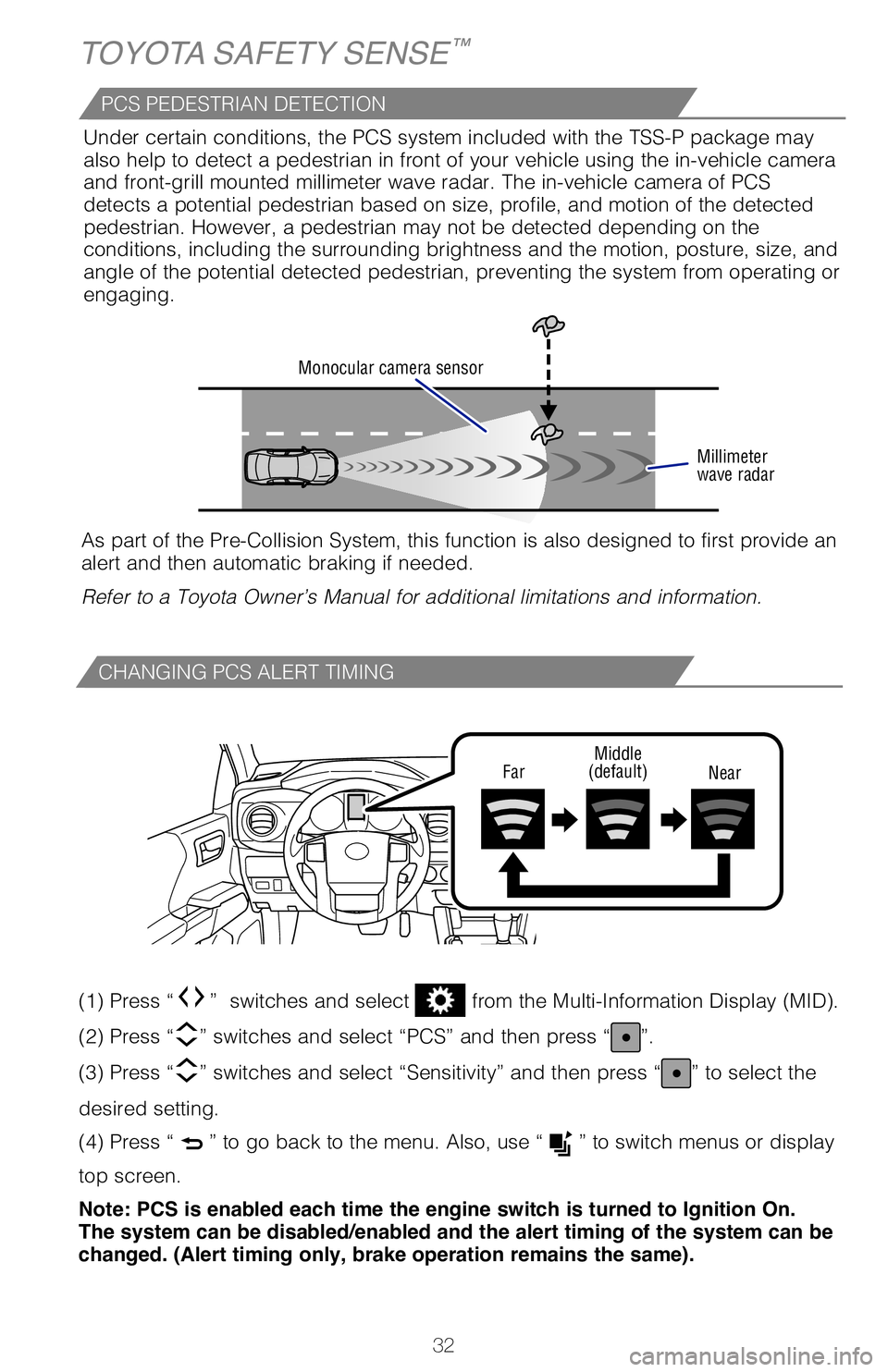
32
DISABLING PRE-COLLISION SYSTEM (PCS)
TOYOTA SAFETY SENSEâ˘
CHANGING PCS ALERT TIMING
FarMiddle
(default) Near
(1) Press ââ switches and select from the Multi-Information Display (MID).
(2) Press â
â switches and select âPCSâ and then press ââ.
(3) Press â
â switches and select âSensitivityâ and then press ââ to select the
desired setting.
(4) Press â
â to go back to the menu. Also, use ââ to switch menus or display
top screen.
Note: PCS is enabled each time the engine switch is turned to Ignition On.
The system can be disabled/enabled and the alert timing of the system can be
changed. (Alert timing only, brake operation remains the same).
(1) Press â â switches and select from the Multi-Information Display (MID).
(2) Press â â switches and select âPCSâ from the MID and then press â
â.
(3) Press â â switches and select âPCSâ and then press â
â to select the desired
setting ON/OFF.
(4) Press â
â to go back to the menu. Also, use â â to switch menus or display
top screen.
Refer to a Toyota Ownerâs Manual for additional information on PCS op\
eration,
settings adjustments, limitations, and precautions before attempting to \
use it.
Monocular camera sensor
Millimeter
wave radar
As part of the Pre-Collision System, this function is also designed to f\
irst provide an
alert and then automatic braking if needed.
Refer to a Toyota Ownerâs Manual for additional limitations and infor\
mation.Under certain conditions, the PCS system included with the TSS-P package\
may
also help to detect a pedestrian in front of your vehicle using the in-v\
ehicle camera
and front-grill mounted millimeter wave radar. The in-vehicle camera of \
PCS
detects a potential pedestrian based on size, profile, and motion of the\
detected
pedestrian. However, a pedestrian may not be detected depending on the
conditions, including the surrounding brightness and the motion, posture\
, size, and
angle of the potential detected pedestrian, preventing the system from o\
perating or
engaging.
PCS PEDESTRIAN DETECTION
LDA in TSS-P uses an in-vehicle camera designed to detect visible white \
and yellow
lane markers in front of the vehicle and the vehicleâs position on th\
e road. If the
system determines that the vehicle is starting to unintentionally deviat\
e from its lane,
the system alerts the driver with an audio and visual alert. When the al\
erts occur,
the driver must check the surrounding road situation and carefully opera\
te the
steering wheel to move the vehicle back to the center part of their lane\
.
LDA is designed to function at speeds of approximately 32 mph (50 km/h)\
or higher
on relatively straight roadways.
142230_MY19_Tacoma_QRG_GUTS.indd 328/13/18 4:07 PM
Page 40 of 60
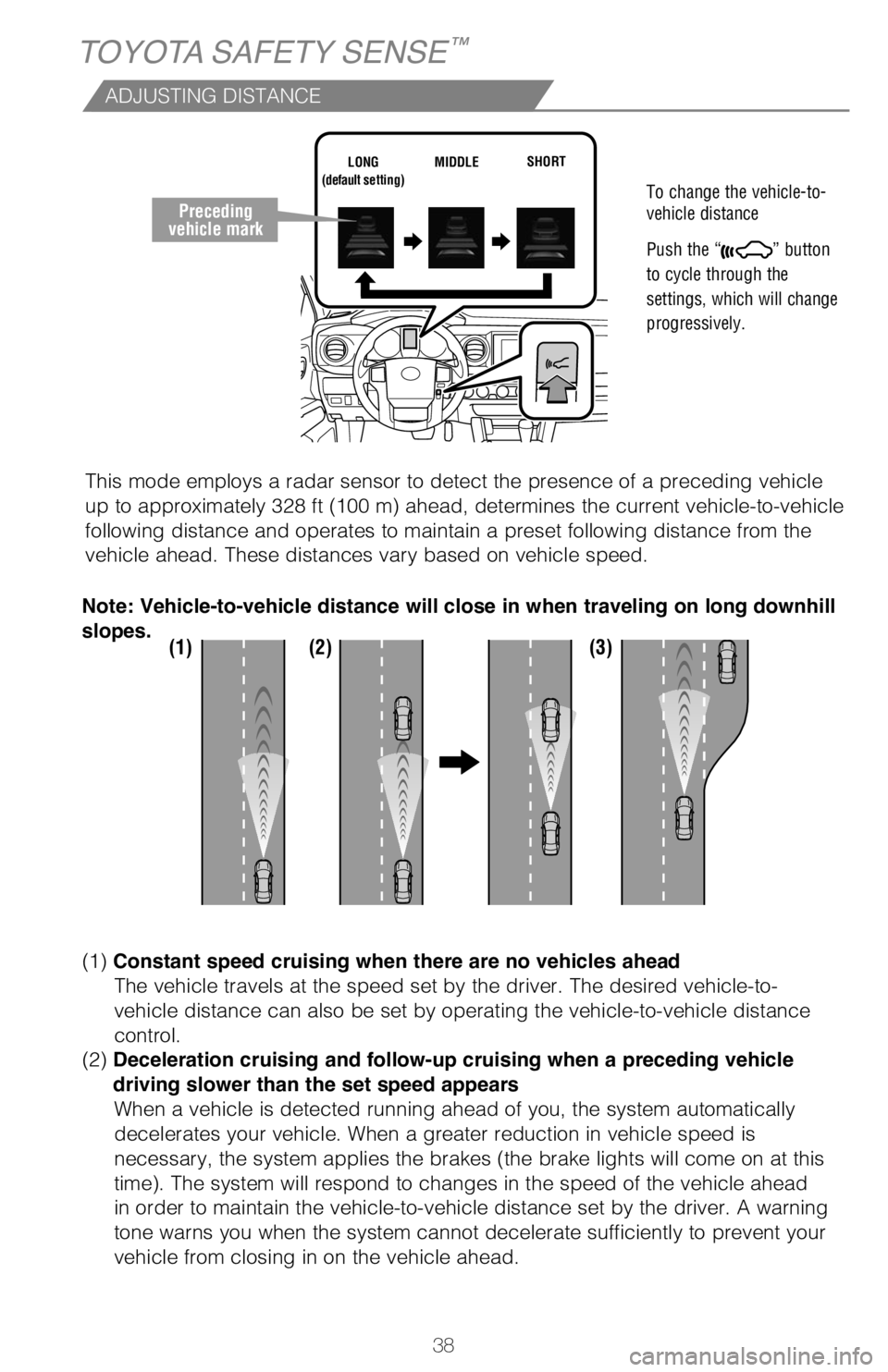
38
SWITCHING TO CONSTANT SPEED (CRUISE) CONTROL MODE
TOYOTA SAFETY SENSEâ˘
ADJUSTING DISTANCE
To change the vehicle-to-
vehicle distance
Push the â
â button
to cycle through the
settings, which will change
progressively.
This mode employs a radar sensor to detect the presence of a preceding v\
ehicle
up to approximately 328 ft (100 m) ahead, determines the current vehic\
le-to-vehicle
following distance and operates to maintain a preset following distance \
from the
vehicle ahead. These distances vary based on vehicle speed.
(1) (2) (3)
(1) Constant speed cruising when there are no vehicles ahead
The vehicle travels at the speed set by the driver. The desired vehicle-\
to-
vehicle distance can also be set by operating the vehicle-to-vehicle dis\
tance
control.
(2) Deceleration cruising and follow-up cruising when a preceding vehicle
driving slower than the set speed appears When a vehicle is detected running ahead of you, the system automaticall\
y
decelerates your vehicle. When a greater reduction in vehicle speed is
necessary, the system applies the brakes (the brake lights will come on\
at this
time). The system will respond to changes in the speed of the vehicle a\
head
in order to maintain the vehicle-to-vehicle distance set by the driver. \
A warning
tone warns you when the system cannot decelerate sufficiently to prevent\
your
vehicle from closing in on the vehicle ahead.
Note: Vehicle-to-vehicle distance will close in when traveling on long downhill
slopes.
Preceding
vehicle mark
LONG
(default setting) MIDDLE
SHORT
SETTING CONSTANT SPEED (CRUISE) CONTROL
Note: When your vehicle is too close to a vehicle ahead, and sufficient automatic
deceleration via the cruise control is not possible, the display will flash and the
buzzer will sound to alert the driver. An example of this would be if another driver
cuts in front of you while you are following a vehicle. Depress the brake pedal to
ensure an appropriate vehicle-to-vehicle distance.
If you are already using DRCC ââ, push button again to turn the system off
first, then push and hold button for at least 1.5 seconds to switch.
Note: When the engine is turned off, it will automatically default to DRCC.
(3) Acceleration when there are no longer any preceding vehicles driving
slower than the set speed The system accelerates until the set speed is reached. The system then
returns to constant speed cruising.
DRCC ADJUSTING DISTANCE (CONTINUED)
Refer to a Toyota Ownerâs Manual for additional information on DRCC o\
peration,
settings adjustments, limitations, and precautions before attempting to \
use it.
To adjust speed or cancel, see steps (2) and (3) of ADJUSTING SET SP\
EED on
page 37.
142230_MY19_Tacoma_QRG_GUTS.indd 388/13/18 4:10 PM
Page 41 of 60
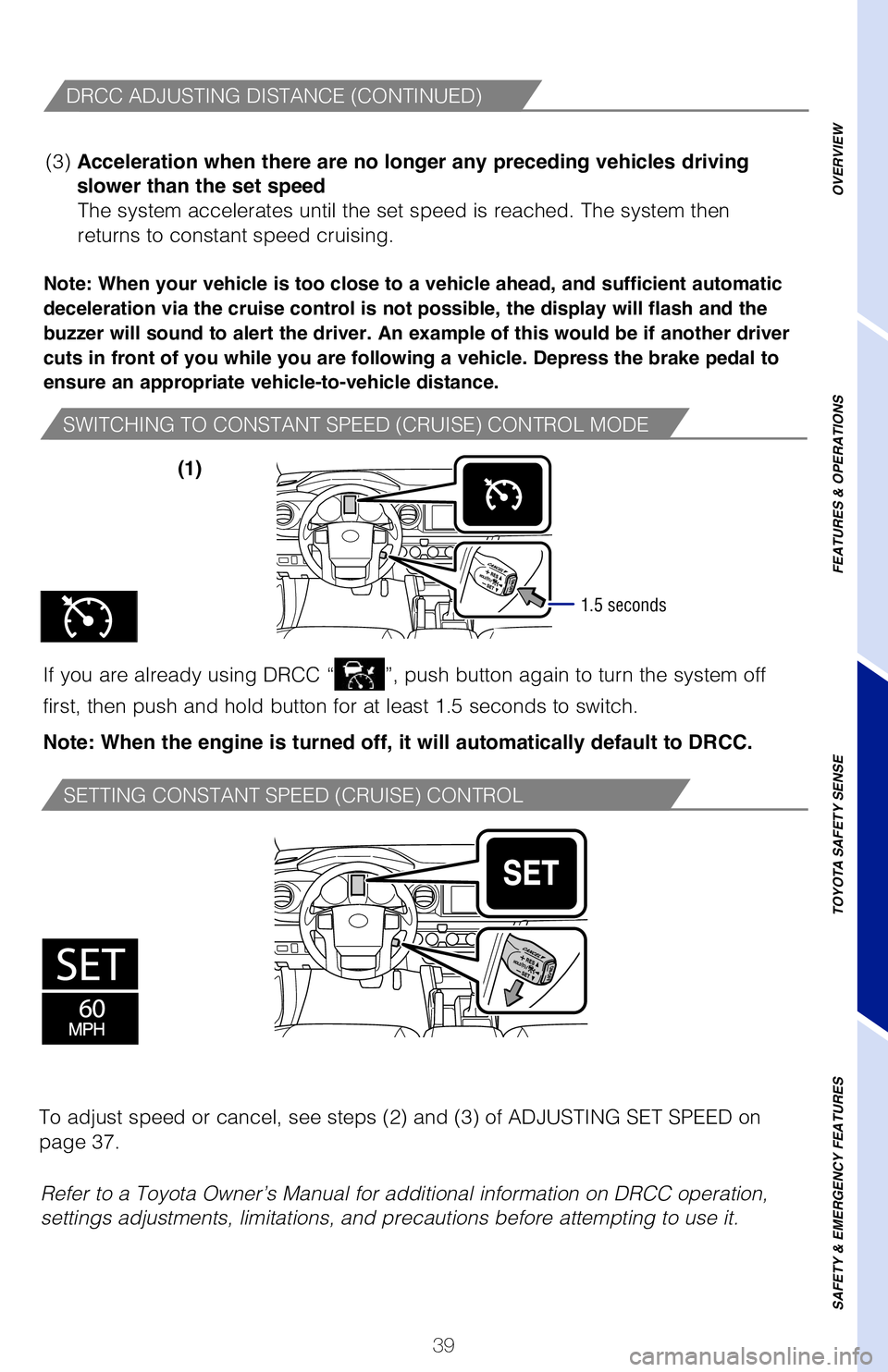
39
SWITCHING TO CONSTANT SPEED (CRUISE) CONTROL MODE
To change the vehicle-to-
vehicle distance
Push the â
â button
to cycle through the
settings, which will change
progressively.
This mode employs a radar sensor to detect the presence of a preceding v\
ehicle
up to approximately 328 ft (100 m) ahead, determines the current vehic\
le-to-vehicle
following distance and operates to maintain a preset following distance \
from the
vehicle ahead. These distances vary based on vehicle speed.
(1) Constant speed cruising when there are no vehicles ahead
The vehicle travels at the speed set by the driver. The desired vehicle-\
to-
vehicle distance can also be set by operating the vehicle-to-vehicle dis\
tance
control.
(2) Deceleration cruising and follow-up cruising when a preceding vehicle
driving slower than the set speed appears
When a vehicle is detected running ahead of you, the system automaticall\
y
decelerates your vehicle. When a greater reduction in vehicle speed is
necessary, the system applies the brakes (the brake lights will come on\
at this
time). The system will respond to changes in the speed of the vehicle a\
head
in order to maintain the vehicle-to-vehicle distance set by the driver. \
A warning
tone warns you when the system cannot decelerate sufficiently to prevent\
your
vehicle from closing in on the vehicle ahead.
Note: Vehicle-to-vehicle distance will close in when traveling on long downhill
slopes.
SETTING CONSTANT SPEED (CRUISE) CONTROL
Note: When your vehicle is too close to a vehicle ahead, and sufficient automatic
deceleration via the cruise control is not possible, the display will flash and the
buzzer will sound to alert the driver. An example of this would be if another driver
cuts in front of you while you are following a vehicle. Depress the brake pedal to
ensure an appropriate vehicle-to-vehicle distance.
If you are already using DRCC ââ, push button again to turn the system off
first, then push and hold button for at least 1.5 seconds to switch.
Note: When the engine is turned off, it will automatically default to DRCC.
(3) Acceleration when there are no longer any preceding vehicles driving
slower than the set speed The system accelerates until the set speed is reached. The system then
returns to constant speed cruising.
1.5 seconds
DRCC ADJUSTING DISTANCE (CONTINUED)
Refer to a Toyota Ownerâs Manual for additional information on DRCC o\
peration,
settings adjustments, limitations, and precautions before attempting to \
use it.
To adjust speed or cancel, see steps (2) and (3) of ADJUSTING SET SP\
EED on
page 37.
(1)
OVERVIEW
FEATURES & OPERATIONS
TOYOTA SAFETY SENSE
SAFETY & EMERGENCY FEATURES
142230_MY19_Tacoma_QRG_GUTS.indd 398/13/18 4:15 PM